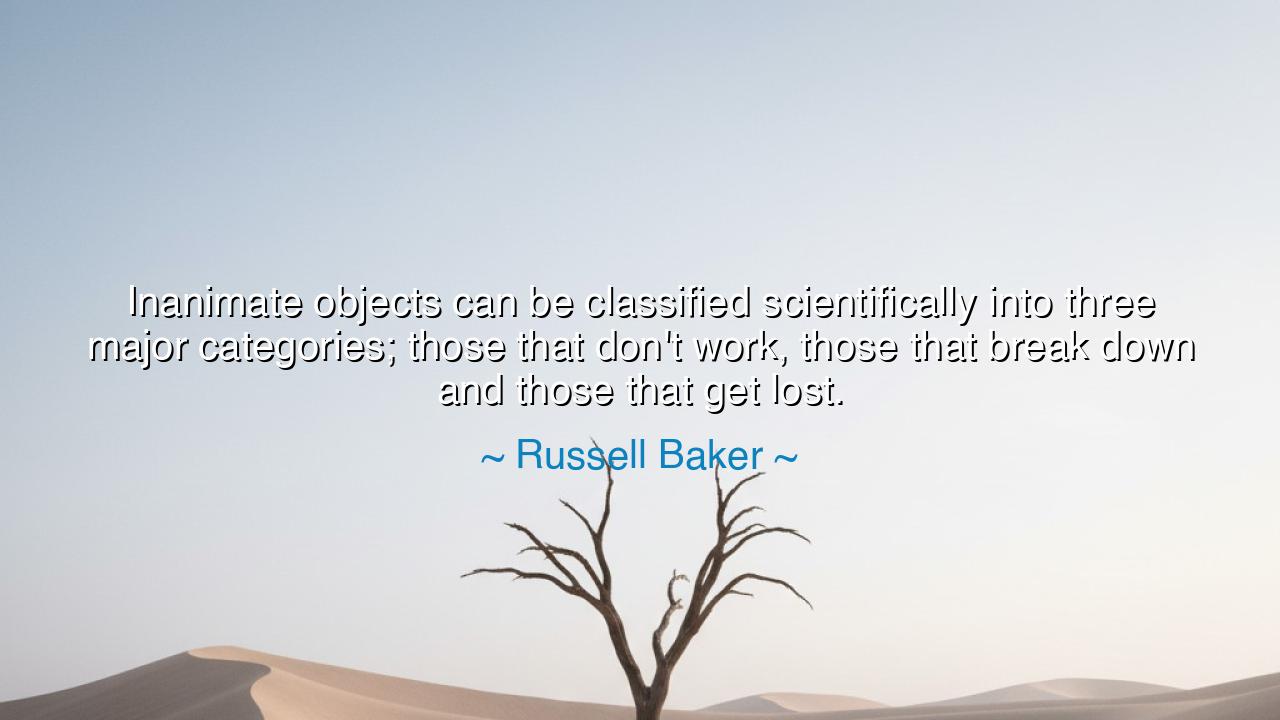
Inanimate objects can be classified scientifically into three
Inanimate objects can be classified scientifically into three major categories; those that don't work, those that break down and those that get lost.






"Inanimate objects can be classified scientifically into three major categories; those that don't work, those that break down and those that get lost." These humorous and sharp words by Russell Baker offer a brilliant yet poignant commentary on the inevitable imperfection of human creation and the nature of life itself. Baker’s statement is not just a lighthearted observation on everyday frustrations with the objects we depend on; it is a reflection on the deeper truth that no matter how advanced our technology, how precise our craftsmanship, or how organized our world may be, there will always be failure, disorder, and loss. It is a recognition that, even in a world ruled by science and rationality, we are constantly faced with the unpredictable and the imperfect.
In the ancient world, great philosophers like Heraclitus and Socrates recognized that the impermanent nature of existence was an unavoidable part of life. Heraclitus famously said, "You cannot step into the same river twice." His words speak to the constant flux of the world, that everything—whether it be a river, a person, or an object—is always changing. The world of inanimate objects is no different. From the simplest tool to the most complex invention, all things are subject to the forces of time, decay, and entropy. Just as Heraclitus saw the world in constant change, Russell Baker reminds us that the very objects we rely on are often fraught with the same imperfections—failure, breakdown, and loss.
Consider the story of Archimedes, the ancient Greek mathematician and engineer, whose inventions and discoveries laid the foundation for modern science and technology. Archimedes, while instrumental in advancing knowledge, also encountered the limitations of his own creations. One of his most famous inventions, the Archimedean screw, designed to lift water for irrigation, was an extraordinary feat of engineering. Yet, for all its brilliance, like all inventions, it was subject to wear and tear, prone to the inevitable breakdowns that come with time and use. Archimedes’ brilliance, though unmatched, could not escape the inherent limitations of the material world. Much like the objects Baker humorously describes, even the greatest inventions can only withstand the forces of decay and failure for so long.
Similarly, Thomas Edison, the inventor of the lightbulb and countless other devices, is a fitting example of how science seeks to solve problems while also confronting the unpredictability of failure. Edison’s lightbulb, for example, was the result of countless failures, as he tested thousands of materials before finding the right filament. His tireless pursuit of perfection was met with a string of failures, yet it was this very perseverance in the face of imperfection that led to success. Edison's ability to learn from each failure is a powerful reminder that failure and breakdown are not signs of weakness, but stepping stones to achievement. Like the objects Baker humorously critiques, Edison’s inventions were not immune to the occasional misstep or breakdown; however, it was through this very process that he was able to create some of the most transformative technologies in history.
In the same way that science and innovation often arise from trial and error, Baker’s quote speaks to the imperfection of human creation. We live in a world where everything, from machines to relationships, is subject to breakdowns, malfunctions, and loss. The natural world, governed by chaos, does not function in neat, predictable patterns. We must learn to accept and even embrace the fact that things will fail, break, and disappear. This is not a failure of science or human will, but rather a reflection of the larger truth that all things in this world are subject to impermanence. Baker’s words invite us to laugh at the frustration that comes from dealing with the unpredictability of life, while also urging us to recognize that failure and loss are part of the human condition.
The lesson from Baker’s observation is one of resilience and humility. The objects we use every day may break down, get lost, or fail to function, but our response to these setbacks is what defines us. Instead of succumbing to frustration or despair, we must learn to adapt. Science, in all its brilliance, has provided us with remarkable tools and inventions. Yet, we must remember that these tools are never flawless, just as we, as human beings, are never perfect. Each breakdown, each failure, is an opportunity for growth and innovation. Through this, we learn not to cling to the illusion of perfection, but to accept the inherent impermanence of life and use it to fuel our pursuit of progress.
In our own lives, we should embrace imperfection with grace and wisdom. Let us remember that the inevitable failures and breakdowns are not setbacks, but the very steps that lead us to success. Whether it is the failure of technology, the loss of something dear, or the frustration of trying to fix what seems broken, we must continue to move forward. As Edison and Archimedes did, we should learn from each breakdown, each failure, and each loss, understanding that it is part of the process of creation. So, let us take Baker’s wisdom to heart, knowing that, in the grand tapestry of life, the broken objects, the lost things, and the failures we encounter are not the end but the beginning of our continued journey.






AAdministratorAdministrator
Welcome, honored guests. Please leave a comment, we will respond soon